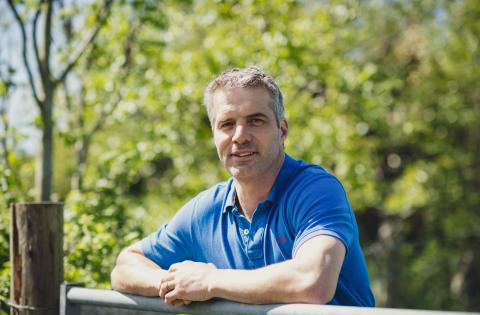In 2003, former IT systems engineer Marc took over a 180 acre farm in Ceredigion which had been in his wife’s family for two generations. By 2011, he had given up the day job and was a full-time, new entrant farmer. His key focus at the outset was on improving the land and expanding the sheep flock. Today, he’s well on the way to creating a fully-sustainable business for the next generation. The acquisition of two more properties with land, a new PV solar system,biomass boiler and an expanding holiday let business are just the start!
“I want to learn how excess electricity can be stored using battery power; to understand more about agri-voltaics and to investigate whether a community-led energy production system could work in West Wales.”
EXECUTIVE SUMMARY
Vertical panels can help Welsh farms harness energy from the sun without loss of land
Vertical solar panels could provide solutions for Welsh farmers who want to generate energy from renewables without sacrificing productive acres.
Llandysul sheep farmer Marc Harries visited Ireland and Germany with the Farming Connect Management Exchange programme to study how bifacial photovoltaic panels could help him invest in renewables without the loss of useable land to a ground mounted installation.
The system works by utilising light shining on both sides of the panel to produce electricity.
“They face east and west, leading to peak solar energy generation in the morning and evening – ideal for dairy farmers,’’ Marc observed.
Energy production is equivalent to a south facing roof-mounted system at a pitch angle of 30-40˚ and up to 15% more than systems on roofs with 10-20˚ pitch angle.
“Being vertical, they use virtually no ground space, livestock can graze alongside and even under the panels,’’ said Marc.
On the farms he visited, he noted that cattle were happy to graze among the panels, which were protected by an electric fence.
The estimated payback on those systems was four to five years assuming 80-90% self-usage with an energy tariff of 25 cents per KWh and FIT (feed in tariff) of 14 cents per KWh.
“With the rising cost of energy, the payback time could be considerably less,’’ Marc noted.
However problems with grid access and capacity can prove to be a major issue and make some installations prohibitively expensive, he added.
Marc, who farms 300 acres, is currently in the process of comparing quotes and payback times for several different systems for use within his farm’s diversification project.
His study also reiterated how, to get the most out of any PV installation, maximising self-usage is a must.
Marc has since ordered a battery storage system for his roof mounted PV system, scheduled to be installed in October.
He also wrote to Julie James MS, minister for climate change, asking her what the future holds for energy production in the agricultural sector.
“In response I was told that there are no plans at present to reintroduce Feed in Tariff system and the current Smart Export Guarantee scheme should provide an adequate return and a good business case for PV investment considering the current high retail energy prices,’’ said Marc.
With the current energy crisis, he is confident that there will be “huge opportunities’’ to develop small scale on-farm renewables in the future.
MANAGEMENT EXCHANGE REPORT


